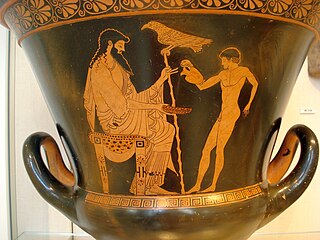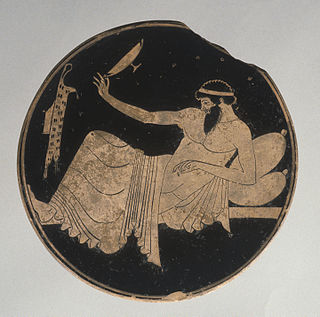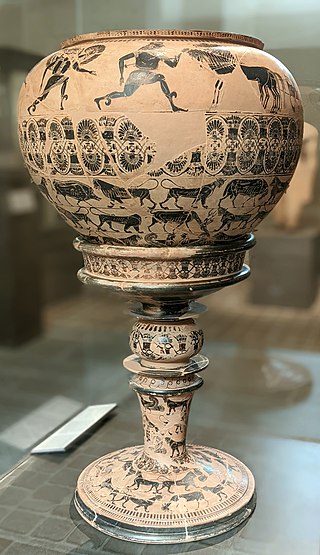
Pottery, due to its relative durability, comprises a large part of the archaeological record of ancient Greece, and since there is so much of it, it has exerted a disproportionately large influence on our understanding of Greek society. The shards of pots discarded or buried in the 1st millennium BC are still the best guide available to understand the customary life and mind of the ancient Greeks. There were several vessels produced locally for everyday and kitchen use, yet finer pottery from regions such as Attica was imported by other civilizations throughout the Mediterranean, such as the Etruscans in Italy. There were a multitude of specific regional varieties, such as the South Italian ancient Greek pottery.

Black-figure pottery painting, also known as the black-figure style or black-figure ceramic, is one of the styles of painting on antique Greek vases. It was especially common between the 7th and 5th centuries BCE, although there are specimens dating as late as the 2nd century BCE. Stylistically it can be distinguished from the preceding orientalizing period and the subsequent red-figure pottery style.

Andokides was an ancient Athenian vase painter, active from approximately 530 to 515 B.C. His work is unsigned and his true name unknown. He was identified as a unique artistic personality through stylistic traits found in common among several paintings. This corpus was then attributed by John D. Beazley to the Andokides Painter, a name derived from the potter Andokides, whose signature appears on several of the vases bearing the painter's work. He is often credited with being the originator of the red-figure vase painting technique. To be sure, he is certainly one of the earliest painters to work in the style. In total, fourteen amphorae and two cups are attributed to his hand. Six of the amphorae are "bilingual", meaning they display both red-figure and black-figure scenes.

The pottery of ancient Greece has a long history and the form of Greek vase shapes has had a continuous evolution from Minoan pottery down to the Hellenistic period. As Gisela Richter puts it, the forms of these vases find their "happiest expression" in the 5th and 6th centuries BC, yet it has been possible to date vases thanks to the variation in a form’s shape over time, a fact particularly useful when dating unpainted or plain black-gloss ware.

The Providence Painter is the conventional name given to a painter of the Attic red-figure style. He was active around 470 BC.

Hermonax was a Greek vase painter working in the red-figure style. He painted between c. 470 and 440 BC in Athens. Ten vases signed with the phrase "Hermonax has painted it" survive, mainly stamnoi and lekythoi. He is generally a painter of large pots, though some cups survive.

The Pan Painter was an ancient Greek vase-painter of the Attic red-figure style, probably active c. 480 to 450 BC. John Beazley attributed over 150 vases to his hand in 1912:
Cunning composition; rapid motion; quick deft draughtsmanship; strong and peculiar stylisation; a deliberate archaism, retaining old forms, but refining, refreshing, and galvanizing them; nothing noble or majestic, but grace, humour, vivacity, originality, and dramatic force: these are the qualities which mark the Boston krater, and which characterize the anonymous artist who, for the sake of convenience, may be called the 'master of the Boston Pan-vase', or, more briefly, 'the Pan-master'.

The Triptolemos Painter was an ancient Greek vase painter, belonging to the Attic red-figure style. He was active in Athens between 490 and 470 BC. His real name is not known. He started working in the workshop of Euphronios, where he was probably taught by Douris. Later, he also worked for the potters Brygos, Hieron and Python. Initially, his style was strongly influenced by Archaic art. His later works are mediocre in quality. Nonetheless, his repertoire is broad, reaching from the Apaturia procession via erotic scenes and Theban scenes to the departure of Triptolemos.

The Foundry Painter was an ancient Greek Attic red-figure vase painter of the Late Archaic period. His real name is unknown; the conventional name is derived from his most famous work, the Berlin Foundry Cup.

Eucharides Painter is the common nickname of an ancient Greek artist who decorated but did not sign Attic vases. Neither his real name, nor the dates of his birth and death are known. Presumably this artist was a pupil of the Nikoxenos Painter.

The Athena Painter was an Attic black-figure vase painter, active about 490 to 460 BC. His speciality were white-ground lekythoi painted in the black-figure style.

The Oreithyia Painter was an ancient Greek red-figure vase painter who flourished from 470–460 BCE. He is one of the many painters of the red-figure Classical Period, but his work is not considered the finest or well-known. This is partly because he began painting during the transition from red-figure to black-figure pottery.

Pamphaios was an Attic potter active around the end of the 6th century BC. Pamphaios was the successor of Nikosthenes in that artist's workshop, and thus took over from one of the most influential and creative potters of antiquity. He probably took over the workshop before 510 BC and continued the tradition of his predecessor by producing typical shapes the latter had developed, such as the Nikosthenic amphora, the Nikosthenic pyxis or the Chalkidian style cup. At times, he developed these shapes further. Unlike Nikostehenes, Pamphaios favoured painters of the red-figure style, which was at the time replacing the previously dominant technique of black-figure vase painting. He also continued to employ many of the painters that had worked for Nikosthenes, such as Oltos, Epiktetos and the Nikosthenes Painter.

The Edinburgh Painter was an Attic black-figure vase painter, active around 500 BC. His speciality was white-ground lekythoi painted in the black-figure style.
The Beldam Painter was an Attic black-figure vase painter, active from around 470 to before 450 BC.
The Chrysis Painter was an anonymous ancient Greek red-figure vase painter who worked in Athens around 420–410 BC. He is identified by his name vase, a hydria now kept in the Metropolitan Museum of Art in New York . which has the name "Chrysis" (ΧΡΥΣΙΣ) inscribed next to the figure of a woman. He has been described as belonging to the school of the Dinos Painter.

The Bryn Mawr Painter is the name given to an Attic Greek red-figure vase painter, active in the late Archaic period.

The Dinos of the Gorgon Painter is an important example of ancient Greek pottery, produced at Athens around 580 BC. It entered the Louvre's collection in 1861, with the purchase of Giampietro Campana's collection.

The Chicago Painter was an ancient Greek vase painter, active in Athens, Greece, in the middle of the 5th century BCE. His real name is unknown, but like many other ancient Greek vase painters, his style was recognized in several works by the British classical archaeologist and international authority of Attic Greek vases, Sir John Beazley (1885–1970). Beazley was exceptionally talented at identifying the individual signature styles of different Greek painters, which could be recognized in something as subtle as the composition of eyes, noses, or hands.

The Villa Giulia Painter was an ancient Greek vase painter, active in Athens, Greece, from about 470 to 440 B.C. His real name is unknown, but like many other ancient Greek vase painters, his style was recognized in several works by the British classical archaeologist and international authority of Attic Greek vases, Sir John Beazley (1885–1970) in his book Attic Red-Figured Vases in American Museums.


















